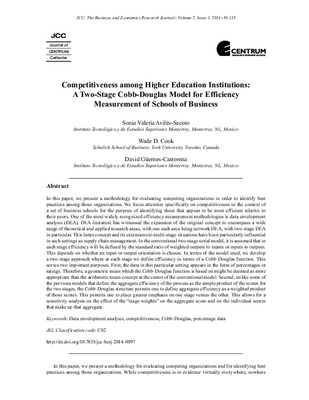| dc.contributor.author | Avilés-Sacoto, Sonia Valeria | |
| dc.contributor.author | Cook, W. D. | |
| dc.contributor.author | Güemes-Castorena, David | |
| dc.date.accessioned | 2023-07-21T19:18:22Z | |
| dc.date.available | 2023-07-21T19:18:22Z | |
| dc.date.issued | 2014 | |
| dc.identifier.uri | https://repositorio.pucp.edu.pe/index/handle/123456789/194832 | |
| dc.description.abstract | In this paper, we present a methodology for evaluating competing organizations in order to identify best practices among those organizations. We focus attention specifically on competitiveness in the context of a set of business schools for the purpose of identifying those that appear to be most efficient relative to their peers. One of the most widely recognized efficiency measurement methodologies is data envelopment analysis (DEA). DEA literature has witnessed the expansion of the original concept to encompass a wide range of theoretical and applied research areas, with one such area being network DEA, with two-stage DEA in particular. This latter concept and its extensions to multi-stage situations have been particularly influential in such settings as supply chain management. In the conventional two-stage serial model, it is assumed that in each stage efficiency will be defined by the standard ratio of weighted outputs to inputs or inputs to outputs. This depends on whether an input or output orientation is chosen. In terms of the model used, we develop a two-stage approach where at each stage we define efficiency in terms of a Cobb-Douglas function. This serves two important purposes. First, the data in this particular setting appears in the form of percentages or ratings. Therefore, a geometric mean which the Cobb-Douglas function is based on might be deemed as more appropriate than the arithmetic mean concept at the center of the conventional model. Second, unlike some of the previous models that define the aggregate efficiency of the process as the simple product of the scores for the two stages, the Cobb-Douglas structure permits one to define aggregate efficiency as a weighted product of those scores. This permits one to place greater emphasis on one stage versus the other. This allows for a sensitivity analysis on the effect of the “stage weights” on the aggregate score and on the individual scores that make up that aggregate. | en_US |
| dc.language.iso | eng | |
| dc.publisher | Pontificia Universidad Católica del Perú. CENTRUM | |
| dc.relation.ispartof | urn:issn:1851-6599 | |
| dc.rights | info:eu-repo/semantics/openAccess | es_ES |
| dc.rights.uri | http://creativecommons.org/licenses/by/4.0 | * |
| dc.source | Journal of CENTRUM Cathedra, Vol. 7, Issue 1 | |
| dc.subject | Cobb-Douglas | en_US |
| dc.subject | Competitiveness | en_US |
| dc.subject | Data envelopment analysis | en_US |
| dc.subject | Percentage data | en_US |
| dc.title | Competitiveness Among Higher Education Institutions: A Two-Stage Cobb-Douglas Model for Efficiency Measurement of Schools of Business | en_US |
| dc.type | info:eu-repo/semantics/article | |
| dc.type.other | Artículo | |
| dc.subject.ocde | https://purl.org/pe-repo/ocde/ford#5.02.04 | |
| dc.publisher.country | PE | |


